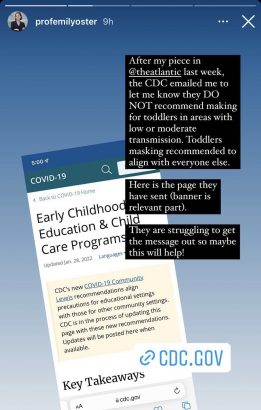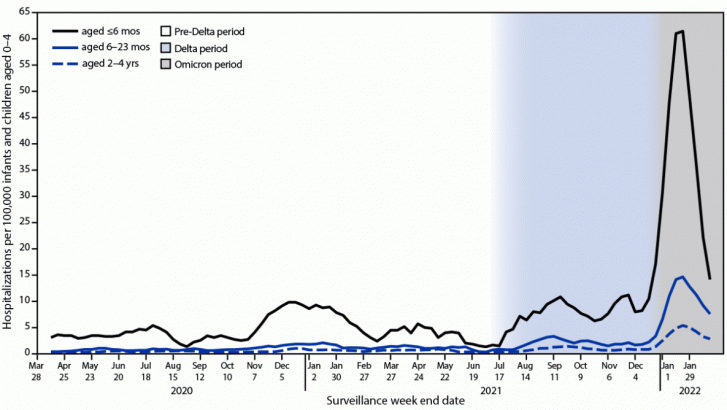An Outdated Website, an Atlantic Article & an Instagram Story: How the CDC Botched Revising Its Mask Guidance for Preschoolers

Get stories like this delivered straight to your inbox. Sign up for The 74 Newsletter
Updated
In early March, a pandemic celebrity best known for advocating that schools should move toward a pre-COVID normal wielded her weapon of choice, arguing in The Atlantic that lifting mask mandates for all but the youngest students is “incredibly irrational.”
Emily Oster laid out what she, and many others, understood to be the situation at hand in her opening paragraph: “Although the CDC recently moved to relax COVID guidelines, it continues to recommend universal indoor masking in early-childhood-education programs for those ages 2 and older.”
The CDC’s coronavirus guidance page for child care providers, last updated Jan. 28, lists a number of “key takeaways,” including that the agency “recommends universal indoor masking in [early childhood education] programs for those ages 2 years and older, regardless of vaccination status.”
But in a surprising twist, about a week later, the Brown University economist posted an update on her Instagram story.
“After my piece in @theatlantic last week, the CDC emailed me to let me know they DO NOT recommend masking for toddlers in areas with low or moderate transmission. Toddlers’ masking recommended to align with everyone else,” she wrote. “They are struggling to get the message out so maybe this will help!”
“I realize that seems a little crazy, but I am telling you that is the email I received from a senior person at the CDC.”

The federal agency has a yellow banner at the top of its early child care COVID guidance page that says the CDC’s latest recommendations “align precautions for educational settings with those for other community settings.”
“That banner … is intended to replace all of the information that is below it in the bullets that say that kids should still be masking,” Oster said in an Instagram video.
In late February, the CDC made major news when it replaced its previous recommendation that all schools require universal masking, stipulating instead that classrooms could now go mask-optional when community COVID rates were low or moderate, the current virus level across most of the country.
But without a vaccine available for those younger than 5, Oster and many others understood the guidance to apply only to K-12 schools, not early child care and pre-K programs. The CDC is “easing its recommendations for wearing masks in indoor K-12 settings,” the Los Angeles Times wrote.
But in fact, the guidance was meant to apply to all educational levels, including those under 5.
In a Thursday email to The 74, the CDC confirmed that “recommendations for masks in K-12 schools and early care and education (ECE) programs are consistent with recommendations for other community settings.”
“Children ages 2-4 have a lower risk of severe disease from COVID-19 and parents of children in ECE programs as well as ECE staff can make appropriate choices about mask wearing in school settings based on local requirements and their personal levels of risk,” wrote spokesperson Jade Fulce.
She did not explain why it has taken the agency several weeks to update its website, but said they would make the information available “as soon as possible.”
To New York City parent Daniela Jampel, whose 4-year-old daughter has continued masking while her older sister goes to school face exposed, the delay is unacceptable.
“It’s ridiculous,” she said. “The CDC is having trouble updating its website so they reach out to Emily Oster?”
“Their website on this issue should not be left to interpretation. It should be very clear,” said Jampel, an early advocate for keeping NYC schools open amid remote learning and now an outspoken critic of the city’s decision to leave masking in place for preschoolers.
Oster agreed that the unconventional communication method underscores the widespread confusion on the issue, but clarified that the CDC did not contact her asking her to spread the word about their policy. Rather, they were correcting what they said was inaccurate information in her Atlantic piece.
“They weren’t like, ‘Oh, by the way, it would be great if you could share with people this information,’” Oster told The 74. “They just said, ‘Everybody should already know this.’ But I think it’s pretty clear looking at … how people responded that they have not managed to make that clear.”
Several parents, mostly in blue states like New Jersey, Connecticut and Illinois, responded to Oster’s update saying that their child care provider was still requiring masks, said the professor.
“I showed this (post) to my provider,” many parents wrote, and in response were told, “Well, if the website still says that masks are required, that’s not our interpretation of what that banner is.”
“There is a fair amount of people looking to this guidance and trying to interpret it and the way that it is currently stated is extremely difficult to interpret clearly,” said Oster.

The confusion extended to The Atlantic itself, which did not immediately update Oster’s original column to reflect the CDC’s clarified guidance after Oster received the agency’s email. In a follow-up interview with The 74, Oster said she corresponded with her editor, but because the CDC had made no official announcement on how to interpret the vague website, the outlet decided not to alter its story at that time.
“[The fact-checker] read the banner at the top, but then everything below it still said there should be masking,” she said. “It went under the radar.”
However, after this story first published and The 74 requested comment from The Atlantic, Oster’s piece was updated Thursday night to reflect the disconnect in the CDC’s guidance between the banner and the information below it.
Many early childhood education providers nationwide continue to require universal masking for 2- to 4-year olds.
Head Start, a federal school readiness program serving over 800,000 children from low-income families each year, continues to require 2-year-olds and up to wear face masks indoors, although in a Jan. 1 ruling, a U.S. district judge put an injunction on the program’s rule in 24 states, mostly Republican. In the remaining 26 states, even those that long ago lifted their school mask mandates, participating toddlers are still required to cover up.
New York City Mayor Eric Adams cited hospitalization data when announcing earlier this month that the country’s largest school district was lifting its K-12 mask mandate but keeping the rule for 2- to 4-year-olds.
“When you look at those under 5, they were more likely to be hospitalized,” Adams said. “People wanted to say, ‘Let’s lift it across the board,’ but that’s not what the science was showing us.”
Masking in early child care settings is associated with a significant drop in program closures due to virus outbreaks, according to a recent study from doctors at Yale University. But the data were collected during the early months of the pandemic before vaccines were available to staff.
And while federal data show that hospitalizations for children under 5 did spike during the Omicron surge, an outsized share of that uptick was driven by newborns not yet 6 months old, who the masking guidance does not apply to anyway.
Meanwhile, COVID cases in Europe are rising sharply, fueled by a more transmissible Omicron subvariant. Even as infections continue to drop across the U.S., many experts warn that the increases across the pond could foreshadow a coming wave in America.

Jampel, despite frustration with the CDC’s haphazard rollout of its guidance for toddlers, doubts whether more clarity would impact the rules affecting her family.
“New York City schools have done many things that go far beyond what the CDC recommends,” she said. “I’m not convinced that it’s the CDC holding us up, and I’m not convinced that a CDC change will mean that our political leaders will take notice and change their policies.”
Neither the Department of Education nor the Department of Health immediately responded to requests for comment.
Steven Barnett, co-director of the National Institute for Early Education Research, said the two key questions on the issue are “What are the health benefits from masking young children?” and “What are the developmental consequences?”
“The problem with trying to be an expert on this issue is that there is very limited science on which to base conclusions,” he told The 74 in an email. “With respect to the health benefits, the known risks to young children from infection are quite small but this is a novel virus with unknown long-term risks.”
“All this leads me to think,” he continued, “that masks for young children may be prudent when there is a high rate of community transmission” — a conclusion that lands him in alignment with the now clarified CDC guidance.
But with all the CDC’s communication glitches along the way, Oster worries it will impact the public’s faith in the agency, which has been shaken several times throughout the two-year pandemic.
“This erodes trust,” she said. “If people are trying to trust the CDC, they’re trying to listen to them, when the messaging is confused in this way, or incomplete in this way, it makes people less likely to pay attention to the CDC.”
Get stories like these delivered straight to your inbox. Sign up for The 74 Newsletter

;)
